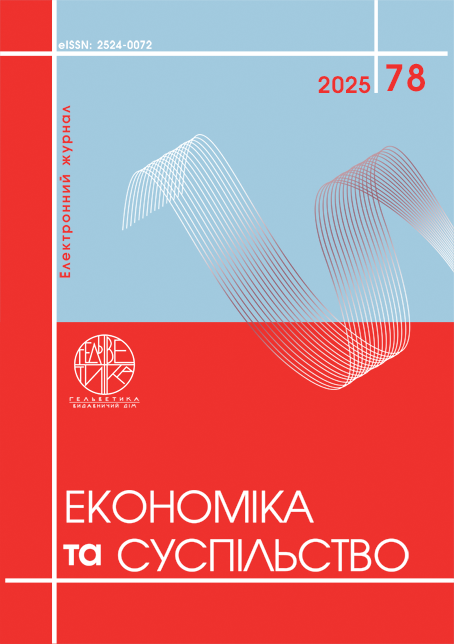THE IMPACT OF MARTIAL LAW ON THE DYNAMICS OF THE STATE ORDER FOR PERSONNEL TRAINING AT VARIOUS EDUCATIONAL LEVELS AND THE FORMATION OF UKRAINE'S INNOVATION POTENTIAL
Abstract
This article comprehensively analyses the profound structural changes in Ukraine's labour market between 2017 and 2024, driven by the COVID-19 pandemic and the full-scale war. The central aim of the study is to provide a systematic analysis of the dynamics of job vacancies, unemployment rates, and the growing imbalance between labour demand and supply. The research leverages official statistical data from the State Statistics Service of Ukraine and the national Open Data Portal to provide a robust, evidence-based assessment. The research identifies significant sectoral shifts, pinpointing specific areas experiencing critical labour shortages and surpluses, particularly within the technology, agriculture, and defence industries. It highlights the severe consequences of these human resource imbalances on the nation's innovation potential, significantly hindering the adoption and implementation of cutting-edge technologies crucial for defence and post-war reconstruction. The research methodology also accounts for the profound impact of socio-demographic factors, including mass migration and military mobilisation, which have induced radical transformations in the employment structure. The findings reveal a dramatic contraction of the labour market in 2022, when vacancies plummeted by 32% compared to 2020, while the official unemployment count dropped to a deceptively low figure. This paradox masks deep-seated problems, such as the destruction of workplaces and a severe outflow of the working-age population. However, the analysis of 2024 data shows an initial sign of market adaptation, with an increase in vacancies and unemployed individuals, signalling a gradual recovery of specific economic sectors. The article demonstrates that while some sectors, such as trade and services, have shown relative resilience, the war deeply affects others, like agriculture and technical specialities. These sectoral imbalances directly result from military actions, supply chain disruptions, and the mobilisation of skilled workers, creating a critical deficit in professions vital for industrial restoration and technological advancement. Conversely, the study identifies a surplus of workers in specific fields, such as freight loaders, sewists, and utility workers. This presents an opportunity for targeted professional retraining and upskilling programs to re-balance the workforce. In conclusion, the study provides a compelling case that a stable socio-economic recovery is unattainable without a systemic and comprehensive approach to transforming human resource policy, adapting state orders for personnel training, and implementing innovative solutions. The findings offer concrete recommendations for a more flexible and responsive state order system that can effectively address the evolving needs of the labour market and capitalise on Ukraine's human capital for a resilient and innovative future. This research, in particular, sheds light on the urgent need for strategic, data-driven decisions to align educational programs with real economic demands and foster the nation's long-term innovative potential in a post-war context.
References
Акімова Л. М., Юрчик Г. М. Особливості функціонування національного ринку праці в умовах військової загрози та внутрішнього переміщення населення. Соціальна економіка. 2024. № 67. С. 15–32. DOI: https://doi.org/10.26565/2524-2547-2024-67-02
Бобко Н. Інноваційна діяльність в Україні: рейтингова оцінка та перспективи розвитку в сучасних умовах. Економічний аналіз. 2024. Т. 34, № 4. С. 294–304. DOI: https://doi.org/10.35774/econa2024.04.294
Ганущак Р. М., Маргасова В. Г. Інноваційні стратегії розвитку бізнесу в умовах повоєнного відновлення економіки України. Journal of strategic economic research. 2024. № 6. С. 166–176. DOI: https://doi.org/10.30857/2786-5398.2023.6.17
Гнатківський Б., Ревенко О., Гудко Т. Обґрунтування тенденції інноваційної діяльності підприємств в Україні та пошук джерел фінансування інноваційного розвитку. Український журнал прикладної економіки та техніки. 2024. Т. 9, № 3. С. 104–108. DOI: https://doi.org/10.36887/2415-8453-2024-4-15
Горященко Ю. Г. Стратегічні імперативи інноваційного розвитку підприємництва в умовах турбулентності. Academic review. 2024. № 2 (61). С. 216–226. DOI: https://doi.org/10.32342/2074-5354-2024-2-61-15
Державна служба статистики України. URL: https://www.ukrstat.gov.ua/ (дата звернення: 22.09.2025)
Іваненко О. Ринок праці і зайнятість під час війни: стан та перспективи. Соціологія: теорія, методи, маркетинг. 2022. № 4. С. 56–75. DOI: https://doi.org/10.15407/sociology2022.04.056
Портал відкритих даних. Набори даних. URL: https://data.gov.ua/dataset (дата звернення: 22.09.2025)
Стаття 72. Формування та розміщення державного замовлення на підготовку фахівців, наукових, науково-педагогічних та робітничих кадрів. Закон України «Про вищу освіту». URL: https://protocol.ua/ua/pro_vishchu_osvitu_stattya_72/ (дата звернення: 22.09.2025)
Kulishov V., Herasymenko Y., Furs O., Pakhomov I. Labour Market of Ukraine and Meeting Post-War Workforce Supply Market Demands. Economics Ecology Socium. 2024. Vol. 8, № 3. P. 27–39. DOI: https://doi.org/10.61954/2616-7107/2024.8.3-3
Akimova L. M., Yurchyk H. M. (2024) Osoblyvosti funktsionuvannia natsionalnoho rynku pratsi v umovakh viiskovoi zahrozy ta vnutrishnoho peremishchennia naselennia [Features of the functioning of the national labor market under the conditions of military threat and internal displacement of the population]. Sotsialna ekonomika – Social Economy, no. 67, pp. 15–32. DOI: https://doi.org/10.26565/2524-2547-2024-67-02 (in Ukrainian)
Bobko N. (2024) Innovatsiina diialnist v Ukraini: reitynhova otsinka ta perspektyvy rozvytku v suchasnykh umovakh [Innovative activity in Ukraine: rating assessment and development prospects in modern conditions]. Ekonomichnyi analiz – Economic Analysis, vol. 34, no. 4, pp. 294–304. DOI: https://doi.org/10.35774/econa2024.04.294 (in Ukrainian)
Hanushchak R. M., Marhasova V. H. (2024) Innovatsiini stratehii rozvytku biznesu v umovakh povoiennoho vidnovlennia ekonomiky Ukrainy [Innovative strategies of business development in the conditions of post-war recovery of Ukraine’s economy]. Journal of strategic economic research, no. 6, pp. 166–176. DOI: https://doi.org/10.30857/2786-5398.2023.6.17 (in Ukrainian)
Hnatkivskyi B., Revenko O., Hudko T. (2024) Obgruntuvannia tendentsii innovatsiinoi diialnosti pidpryiemstv v Ukraini ta poshuk dzherel finansuvannia innovatsiinoho rozvytku [Substantiation of trends of innovative activity of enterprises in Ukraine and search for sources of financing innovative development]. Ukrainskyi zhurnal prykladnoi ekonomiky ta tekhniky – Ukrainian Journal of Applied Economics and Technology, vol. 9, no. 3, pp. 104–108. DOI: https://doi.org/10.36887/2415-8453-2024-4-15 (in Ukrainian)
Horiashchenko Yu. H. (2024) Stratehichni imperatyvy innovatsiinoho rozvytku pidpryiemnytstva v umovakh turbulentnosti [Strategic imperatives of innovative development of entrepreneurship in conditions of turbulence]. Academic review, no. 2(61), pp. 216–226. DOI: https://doi.org/10.32342/2074-5354-2024-2-61-15 (in Ukrainian)
Derzhavna sluzhba statystyky Ukrainy [State Statistics Service of Ukraine]. Available at: https://www.ukrstat.gov.ua/ (accessed September 22, 2025) (in Ukrainian)
Ivanenko O. (2022) Rynok pratsi i zainiatist pid chas viiny: stan ta perspektyvy [Labor market and employment during the war: state and prospects]. Sotsiolohiia: teoriia, metody, marketynh – Sociology: Theory, Methods, Marketing, no. 4, pp. 56–75. DOI: https://doi.org/10.15407/sociology2022.04.056 (in Ukrainian)
Portal vidkrytykh danykh. Nabory danykh [Open Data Portal. Datasets]. Available at: https://data.gov.ua/dataset (accessed September 22, 2025) (in Ukrainian)
Zakon Ukrainy «Pro vyshchu osvitu» [Law of Ukraine "On Higher Education"]. Stattya 72. Formuvannia ta rozmishchennia derzhavnoho zamovlennia na pidhotovku fakhivtsiv, naukovykh, naukovo-pedahohichnykh ta robitnychykh kadriv [Article 72. Formation and placement of the state order for the training of specialists, scientific, scientific-pedagogical and working personnel]. Available at: https://protocol.ua/ua/pro_vishchu_osvitu_stattya_72/ (accessed September 22, 2025) (in Ukrainian)
Kulishov V., Herasymenko Y., Furs O., Pakhomov I. (2024) Labour Market of Ukraine and Meeting Post-War Workforce Supply Market Demands. Economics Ecology Socium, vol. 8, no. 3, pp. 27–39. DOI: https://doi.org/10.61954/2616-7107/2024.8.3-3
Copyright (c) 2025 Олександр Кушнерьов

This work is licensed under a Creative Commons Attribution 4.0 International License.


